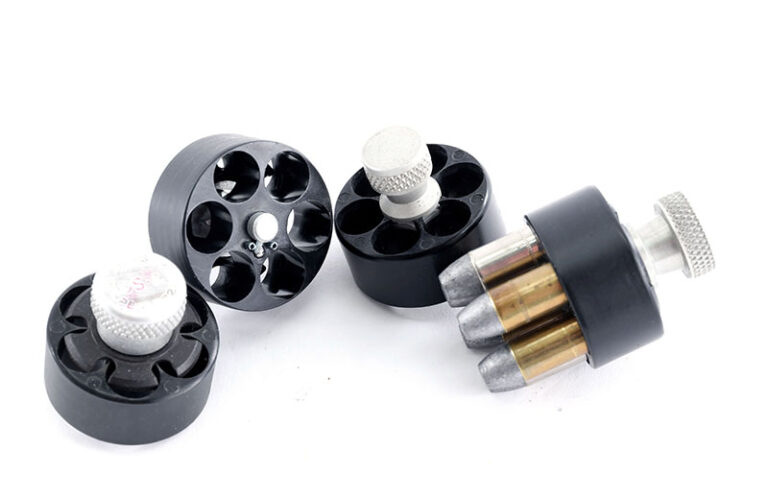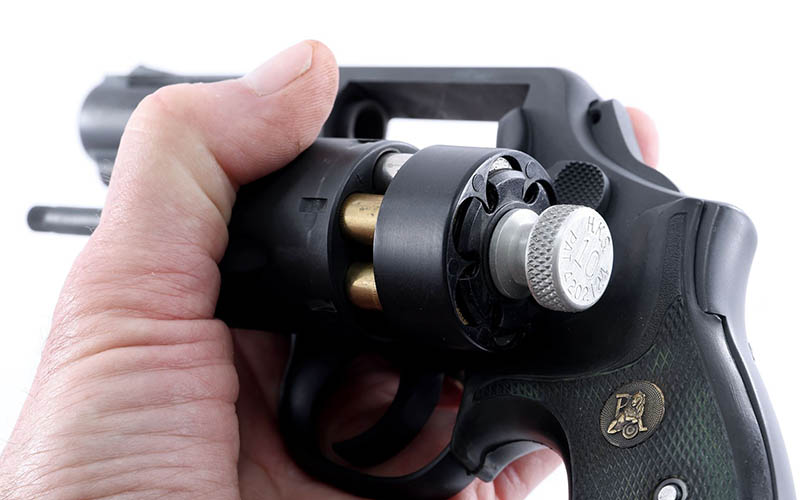
If you carry a defensive revolver, you’re going to want an HKS speedloader.
I still remember the first time I saw an HKS speedloader in action.
I was working at The Gun Room, and the boss, Mike Karbon, found and stocked them. When we made a sale for a duty-type or defensive revolver (which were most sales back then, being next to Detroit in the 1980s), he’d say, “You’ll want a speedloader with that.” Most were dubious, as it was a new thing, and most were suspicious.
Mike had a demo loader he’d pick up, hurling it across the shop floor to ricochet off the floor, into a corner and off a strategically placed wooden ammo crate. The customer would pick it up, and then Mike would hold it up, turn the knob and the rounds would drop free. Sale made.
Made of durable plastic (before “polymer” became a household word) and aluminum, the demo rounds in it wouldn’t chamber and should never have gotten fired, but the HKS worked.
The durability of the HKS came with some minor downsides, however. First, it was caliber and revolver specific. Caliber is understandable, as you wouldn’t expect a .38 speedloader to hold .44s or vice versa. But the cylinder diameters on various revolvers differed, and the spacing had to be just right for the rounds to drop out of the HKS and into the cylinder. As a result, we had to stock the full range just to be covered. This was despite most of our customers being Detroit PD, with most carrying .41s, .44s and .45s. Still, someone who packed a five-shot J-frame often wanted extra ammo, too, so we stocked the full line.
A quick current check turns up HKS, and the full line is even fuller. From .22 LR up to .45, I count 21 models fitting a host of revolvers, mostly S&W, Colt, Ruger and Taurus. That’s most of the wheelguns now, isn’t it?
Nothing Is Perfect
The HKS does have some minor drawbacks.
First of all, the lock and release is a rotating knob. The cylinder of your revolver must be pinned in place (a thumb or fingertips will do that with proper technique), or turning the knob just spins the cylinder. There’s no spring propulsion, so the muzzle must be pointed down to load. You need gravity, and gravity only works in one direction. Their durability means a certain amount of bulk. Loading strips, flat plastic/rubber strips that hold five or six rounds in a line, can be pocketed or carried in a flatter pouch. They aren’t as fast or secure as an HKS, but they are flatter.

Lastly, while the HKS webpage gives you info, you can’t order them. You have to go to a retailer or an online store. The simplicity of their design means that had revolvers remained as mainline defensive carry handguns, we’d be buried under Chinese clones. But HKS speedloaders (assuming you don’t get taken by copies) are made in the United States, from materials made in the United States.
It didn’t take long before Mike had to retire that HKS speedloader. Not because he broke it—word quickly spread, and he no longer had to do the demo … despite speedloaders, as a uniform item, not being on the approved-wear list. That said, Detroit PD officers didn’t care, and their shift supervisors knew that if they did an inspection and made officers take them off, the HKS pouches and loaders would be back on their officer’s belts before anyone’s first cup of coffee had gotten cold.
When something is so good that people will break the rules to use it, you know it’s good.
Editor's Note: This article originally appeared in the August 2023 issue of Gun Digest the Magazine.
More On Speedloaders:
- Speedloader Techniques For Reloading Revolvers
- The CrossBreed Speedloader Case
- Picking Up The Pace With The Ripcord Speedloader
- First Look: Zeta6 K-PAK Speedloader

Next Step: Get your FREE Printable Target Pack
Enhance your shooting precision with our 62 MOA Targets, perfect for rifles and handguns. Crafted in collaboration with Storm Tactical for accuracy and versatility.
Subscribe to the Gun Digest email newsletter and get your downloadable target pack sent straight to your inbox. Stay updated with the latest firearms info in the industry.

![Best Concealed Carry Guns In 2025 [Field Tested] Wilson Combat EDC X9S 1](https://gundigest.com/wp-content/uploads/Wilson-Combat-EDC-X9S-1-324x160.jpg)


![Best 9mm Carbine: Affordable PCCs [Tested] Ruger Carbine Shooting](https://gundigest.com/wp-content/uploads/Ruger-Carbine-Shooting-100x70.jpg)
![Best AR-15: Top Options Available Today [Field Tested] Harrington and Richardson PSA XM177E2 feature](https://gundigest.com/wp-content/uploads/Harrington-and-Richardson-PSA-XM177E2-feature-100x70.jpg)
